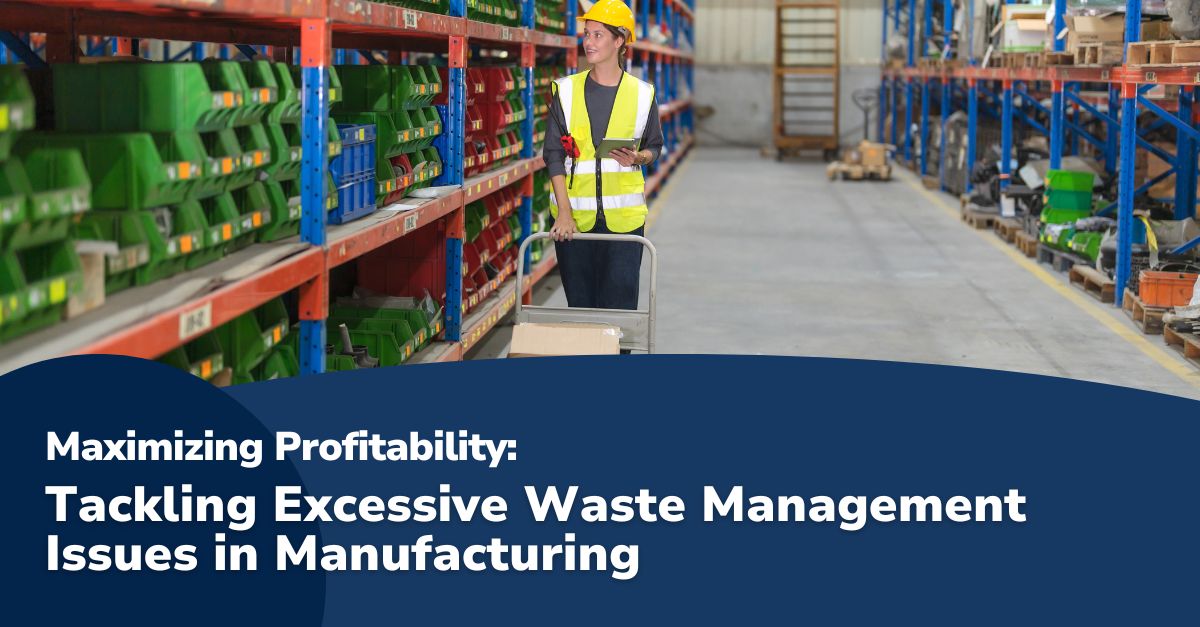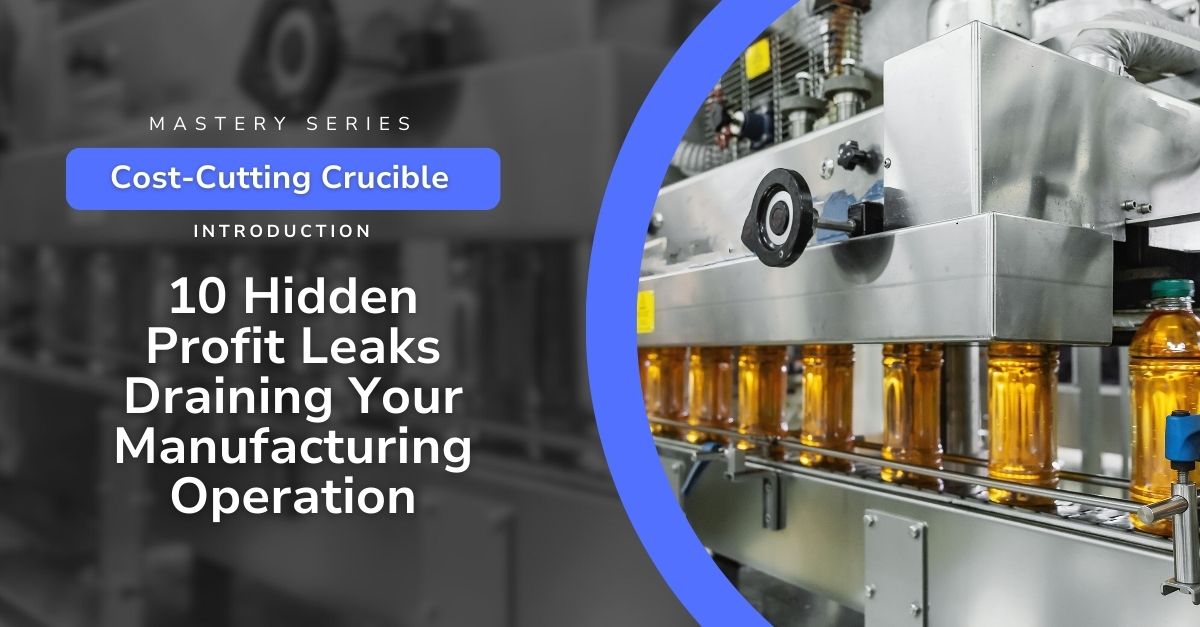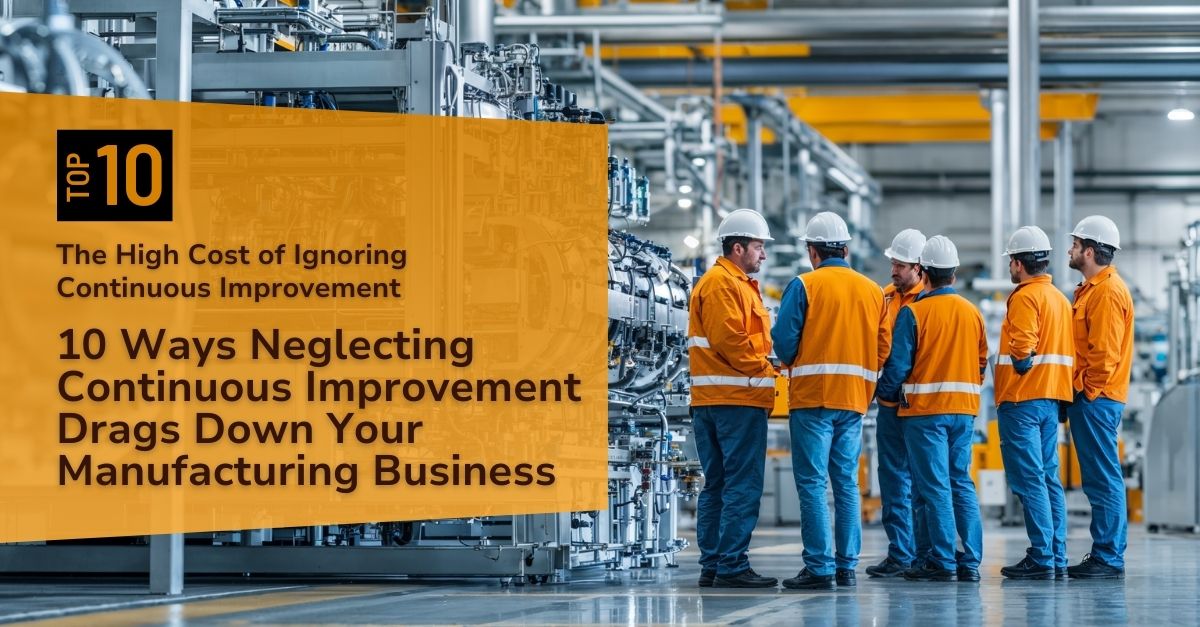
Most manufacturers know waste is costly. But many still underestimate the full financial impact it has across their operations.
Waste isn’t just something that shows up as scrap on the shop floor or spoilage in storage. It drives downstream costs that ripple through capacity planning, labor productivity, regulatory exposure, and even customer relationships.
The challenge of managing added waste in manufacturing is not just about dealing with the aftermath of production processes but also understanding and mitigating its wide-ranging effects.
These include increased operational costs and compromised product quality, which can significantly detract from a company’s profitability and commitment to sustainable practices. Effective waste management is thus not merely a regulatory obligation but a strategic imperative that can differentiate a company in a competitive marketplace.
Embracing lean manufacturing and waste minimization principles offers a path forward. These approaches not only aim to reduce the physical waste generated on the production floor but also seek to optimize the entire manufacturing process—minimizing inefficiencies, enhancing resource utilization, and ultimately driving down costs associated with waste management. This series of installments will explore strategic insights, actionable steps, and best practices that can empower manufacturers to transform waste management from a cost center into a lever for achieving greater profitability.
By providing a comprehensive exploration of added waste management expenses and their far-reaching implications, this post will guide manufacturing leaders looking to navigate the complexities of modern production environments. Through expert analysis and practical recommendations, we aim to equip manufacturers with the knowledge and tools needed to turn the waste management challenge into an operational refinement and competitive advantage opportunity.
1Capacity Utilization:
The Problem: Poor utilization of your available production capacity doesn’t just create downtime, it inflates your per-unit costs. When lines are underused or misaligned with real customer demand, manufacturers often default to producing extra inventory to stay “busy.” That excess output often leads to outdated, unsold, or expired product that ends up as waste.
What to Do: Invest in tools that connect forecasting with scheduling so you can run the right product at the right time in the right quantity. Look at historical demand patterns, current inventory levels, and customer lead time expectations, not just production targets. Strategic use of Overall Equipment Effectiveness (OEE) data also helps pinpoint when and where you’re underutilizing assets so you can adjust proactively.
2Resource Inefficiency:
The Problem: Wasted materials, energy, and water quickly drive up operational costs. Whether it’s due to leaky processes, aging equipment, or poor quality control, resource inefficiency translates to real dollars lost. Often, the signs are subtle, excess trimmings, repeated changeovers, machines that burn more energy than needed, but the financial toll is significant.
What to Do: Conduct regular and detailed resource audits that look at consumption trends across shifts, departments, and products. Engage frontline staff in identifying everyday sources of waste they see firsthand. Prioritize fixes that deliver both environmental and financial ROI, such as optimizing material yield, improving first-pass quality, and reducing utility usage through upgraded systems and behavioral changes.
3Production Delays:
The Problem: Unplanned downtime doesn’t just stall output. It causes waste through material spoilage, overtime labor costs, excessive changeovers, and sometimes emergency shipments to meet deadlines. The longer the delay, the higher the likelihood that something will need to be scrapped, reworked, or rushed.
What to Do: Move from reactive to predictive maintenance using real-time monitoring and analytics. Analyze root causes of past disruptions, not just the immediate failure, but the upstream issues like inadequate training or skipped inspections. Improve cross-functional communication between production, maintenance, and supply planning to ensure issues are surfaced early and addressed completely.
4Innovation Stagnation:
The Problem: Legacy systems and old habits create invisible waste that accumulates over time. When manufacturers fail to modernize processes or adopt new tools, they often continue inefficient practices because “they still work.” This stagnation makes it harder to improve yield, reduce cycle time, or eliminate repeat quality issues.
What to Do: Carve out time and budget for controlled experimentation. Launch small-scale innovation pilots on the line using lean problem-solving teams or cross-trained improvement crews. Track not just the outcome, but the learnings from these pilots, and build a pathway for scaling successful changes. Make continuous improvement part of the daily rhythm, not just a once-a-year initiative.
5Employee Morale and Productivity:
The Problem: Wasteful environments can demoralize even the best teams. If employees see rework piling up, processes being ignored, or no follow-through on their feedback, motivation drops. That leads to disengagement, errors, absenteeism, and slower problem response, all of which add to operational waste.
What to Do: Build a culture where operators are empowered to spot and solve problems at the source. Give teams simple visual tools to track progress and waste reduction. Celebrate improvements and close the loop on suggestions. When employees feel their input matters and results are visible, they become stronger stewards of productivity and quality.
6Supply Chain Disruptions:
The Problem: Volatile supply chains can quickly turn into waste generators. Late shipments of critical materials lead to idle workers, missed deadlines, or costly last-minute substitutions. On the other end, receiving too much inventory too soon leads to spoilage, expiration, or quality deterioration in storage.
What to Do: Strengthen relationships with tier-one and tier-two suppliers by improving forecast accuracy and information sharing. Build flexibility into your procurement and inventory systems by using buffer zones that allow you to pivot when issues arise. Consider alternative sourcing options for high-risk materials and reevaluate stocking strategies for perishables and just-in-time components.
7Customer Satisfaction:
The Problem: Quality problems, missed delivery windows, and inconsistent performance are all symptoms of internal waste, and they directly affect how your customers view your reliability. Dissatisfied customers don’t just leave. They drive up warranty claims, increase support costs, and make it harder to win future business.
What to Do: Connect quality metrics directly to customer outcomes. Make it easy for sales and service teams to report back product performance trends and delivery complaints so they inform upstream improvements. Use those insights to tighten your specs, streamline packaging processes, or adjust batch sizes to better match customer usage patterns.
8Market Competitiveness:
The Problem: In a cost-sensitive and increasingly sustainable economy, the most competitive manufacturers are the most efficient ones. Companies that fail to minimize waste are often slower to respond to market shifts, unable to compete on price, and overlooked by customers prioritizing environmental performance.
What to Do: Treat waste reduction as a value proposition. Include efficiency wins and sustainability progress in your customer-facing messaging. Back it up with measurable results, less water used per unit, fewer returns per thousand shipped, or faster order fulfillment. These metrics can be differentiators in tight procurement negotiations.
9Regulatory and Compliance Risks:
The Problem: The cost of non-compliance adds up fast, fines, shutdowns, increased audits, and long-term reputational damage. Many manufacturers are caught off guard not because they lack the intent to comply, but because they don’t have systems in place to catch and resolve issues before they escalate.
What to Do: Align your compliance approach with your production rhythms. That means integrating waste tracking, materials handling, emissions reporting, and labeling requirements into your daily routines. Train key roles on what compliance looks like in practice, not just in policy. And run periodic drills or audits to test system readiness.
10Long-Term Financial Health:
The Problem: Waste creates a long-term drag on profits that isn’t always obvious in monthly reports. It slowly drains your ability to reinvest, pursue new growth opportunities, and weather economic changes. The result is a business that looks stable on the surface but is slowly losing momentum.
What to Do: Identify the recurring forms of waste that have the highest cumulative cost, not just the biggest one-time events. Look for trends in excess inventory write-offs, rework hours, or unsold stock. Quantify these over multiple quarters and treat them as strategic risks to be mitigated. This long-term lens will help you prioritize high-leverage improvements.
Conclusions for Manufacturing Leaders
As this installment of our Maximizing Profitability Mastery Series draws to a close, it’s evident that mastering waste management is more than a compliance requirement; it’s a strategic cornerstone for achieving sustainable growth and operational efficiency. The journey toward minimizing waste and maximizing efficiency is intricate, demanding a holistic approach encompassing lean manufacturing and waste minimization principles. These methodologies are not merely strategies but foundational elements that enable manufacturing entities to strive toward excellence in their operations.
Whether you’re looking to trim waste in a specific area or overhaul your operational performance, our team has the tools and experience to help you get there.
They open doors to innovation, operational cost reductions, and a distinctive position in the competitive landscape—the commitment to operational efficiency and resource optimization.
A Partnership with POWERS for Transformation
In navigating the multifaceted landscape of waste management, the value of partnering with seasoned experts cannot be overstated. POWERS stands at the vanguard of guiding manufacturing firms through this transformative journey, leveraging lean manufacturing insights and waste reduction strategies to usher in a new era of operational excellence.
Our methodology is deeply ingrained in a comprehensive understanding of manufacturing sector dynamics, offering clients a partnership that transcends traditional consultancy.
Engaging with POWERS opens the gateway to a wealth of expertise and methodologies honed to streamline operations, curtail waste, and bolster profitability. Our collaborative ethos ensures that tailored strategies are conceptualized and executed in alignment with each client’s specific operational objectives.
In collaboration with POWERS, manufacturing companies can anticipate a partnership that addresses the pressing challenges of waste management and strategically positions them for enduring growth and market leadership. Our commitment to your success is unwavering, with continuous support to ensure the sustainable impact of our joint efforts.
Initiating a Legacy of Excellence and Sustainability
Partnering with POWERS signifies a transformative journey towards operational efficiency and a sustainable industrial future. Together, we will confront challenges head-on, unlocking new avenues of opportunity and securing remarkable achievements that resonate both within your organization and the broader manufacturing landscape.
This collaboration is an invitation to redefine what it means to be efficient, sustainable, and competitive in today’s manufacturing world. With POWERS by your side, the aspirations of achieving sustainable and profitable manufacturing operations transition from ambitious goals to achievable realities.
With the support of our Digital Production System (DPS), your teams get real-time visibility into KPIs that matter, waste, throughput, delays, and more. Every shift becomes an opportunity to take control of costs and deliver better results.
Take the first step towards revolutionizing your manufacturing processes and unlocking unprecedented operational efficiency and savings. Reach out to POWERS today to discover how our expertise can facilitate your company’s evolution towards excellence. Connect with us at +1 678-971-4711 or via email at info@thepowerscompany.com.
Continue Reading from this Mastery Series
- Part 1 - How Runaway Costs Derail Manufacturers’ Drive for Sustainability
- Part 2 - Tackling Excessive Waste Management Issues in Manufacturing
- Part 3 - Mastering Resource Efficiency in the Quest for Manufacturing Excellence
- Part 4 - The Impact of Unmitigated High Energy Costs on Manufacturers
- Part 5 - How the Complexities of Regulatory Compliance Can Erode Margins
- Part 6 - Navigating the Challenges of Reduced Market Competitiveness for Sustained Profitability
- Part 7 - Don’t Let Preferences Pull You Under
- Part 8 - Low Talent Investment is Undermining Your Bottom Line
- Part 9 - Don’t Let Supply Chain Vulnerabilities Bleed Your Profits
- Part 10 - Outsmart the Competition and Protect Your Profits







